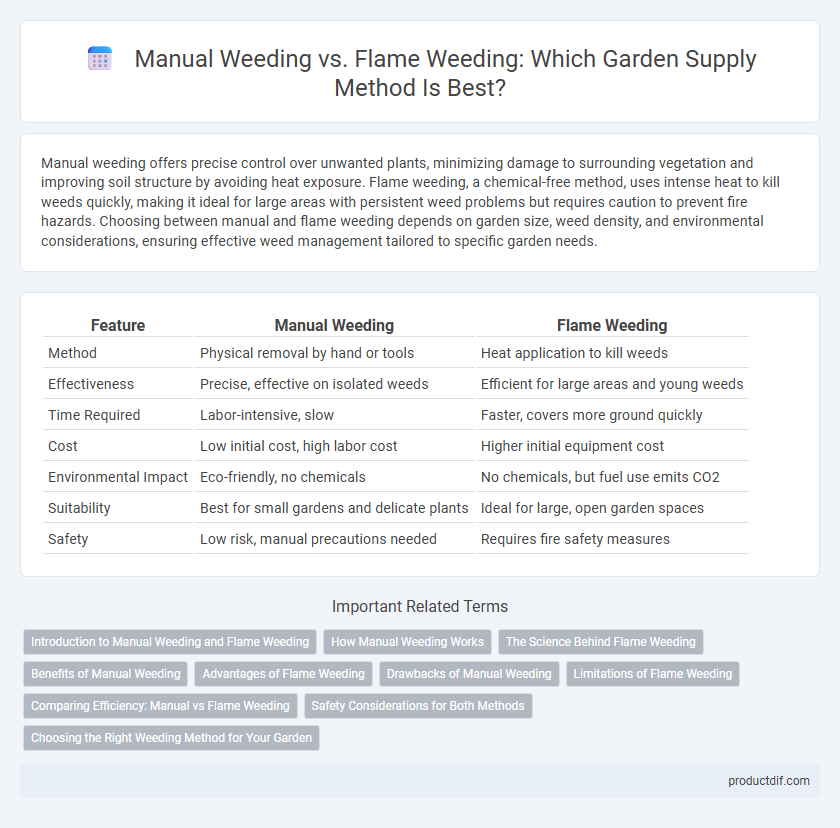Manual weeding offers precise control over unwanted plants, minimizing damage to surrounding vegetation and improving soil structure by avoiding heat exposure. Flame weeding, a chemical-free method, uses intense heat to kill weeds quickly, making it ideal for large areas with persistent weed problems but requires caution to prevent fire hazards. Choosing between manual and flame weeding depends on garden size, weed density, and environmental considerations, ensuring effective weed management tailored to specific garden needs.
Table of Comparison
| Feature | Manual Weeding | Flame Weeding |
|---|---|---|
| Method | Physical removal by hand or tools | Heat application to kill weeds |
| Effectiveness | Precise, effective on isolated weeds | Efficient for large areas and young weeds |
| Time Required | Labor-intensive, slow | Faster, covers more ground quickly |
| Cost | Low initial cost, high labor cost | Higher initial equipment cost |
| Environmental Impact | Eco-friendly, no chemicals | No chemicals, but fuel use emits CO2 |
| Suitability | Best for small gardens and delicate plants | Ideal for large, open garden spaces |
| Safety | Low risk, manual precautions needed | Requires fire safety measures |
Introduction to Manual Weeding and Flame Weeding
Manual weeding involves physically removing weeds by hand or with simple tools, preserving soil structure and preventing chemical use in gardens. Flame weeding uses controlled bursts of heat from propane-powered devices to kill weeds by damaging their cell structure without disturbing the soil. Both methods effectively manage unwanted plants, but manual weeding offers precision while flame weeding provides rapid coverage for larger areas.
How Manual Weeding Works
Manual weeding involves physically removing weeds by hand or with simple tools like hoes and hand forks, targeting the root system to prevent regrowth. This method allows for precise control, minimizing damage to surrounding plants and preserving soil integrity. Although labor-intensive, manual weeding is effective in organic gardening and small-scale garden beds where chemical or heat-based alternatives might harm desirable plants.
The Science Behind Flame Weeding
Flame weeding uses intense heat from propane-fueled torches to disrupt plant cell structures, causing rapid dehydration and cell rupture, effectively killing weeds without chemicals. Unlike manual weeding, flame weeding targets the weed's vascular tissues, halting nutrient flow and preventing regrowth. This thermochemical process offers an eco-friendly alternative that reduces soil disturbance and promotes sustainable garden maintenance.
Benefits of Manual Weeding
Manual weeding offers precise control by allowing gardeners to remove specific unwanted plants without damaging surrounding vegetation, making it ideal for delicate garden beds. It enhances soil health by minimizing disturbance to beneficial microorganisms and preventing soil erosion compared to flame weeding. This method is environmentally friendly, reducing the need for chemical herbicides and eliminating risks associated with fire, ensuring safer use in various garden settings.
Advantages of Flame Weeding
Flame weeding offers the advantage of rapid and efficient weed control without soil disturbance, preserving soil structure and beneficial organisms. This method reduces reliance on chemical herbicides, promoting eco-friendly gardening practices. Its ability to target weeds in hard-to-reach areas enhances overall garden maintenance and crop health.
Drawbacks of Manual Weeding
Manual weeding demands significant physical effort and time, making it inefficient for large garden areas. It often fails to remove deep-rooted weeds completely, leading to regrowth and increased labor. Moreover, repetitive bending and kneeling can cause strain and injury, reducing long-term gardening productivity.
Limitations of Flame Weeding
Flame weeding is limited by its inability to effectively control deep-rooted or perennial weeds, as the heat primarily damages above-ground parts without completely destroying underground structures. The technique poses fire hazards, especially in dry, windy conditions, requiring careful monitoring and safe practices to prevent accidental fires. Furthermore, flame weeding is less suitable for mulched or densely planted garden beds, where excessive heat may damage desirable plants or soil microorganisms.
Comparing Efficiency: Manual vs Flame Weeding
Manual weeding requires significant time and physical effort, making it less efficient for large areas, whereas flame weeding rapidly eliminates weeds with targeted heat application, reducing labor intensity. Flame weeding effectively controls annual weeds and seedlings but may be less efficient on deep-rooted or perennial species compared to manual removal. Choosing between manual and flame weeding depends on garden size, weed type, and desired speed of weed control.
Safety Considerations for Both Methods
Manual weeding offers greater control and minimizes fire risks, making it safer for small gardens and areas with flammable materials. Flame weeding requires strict adherence to safety protocols, including using protective gear and avoiding dry, windy conditions to prevent accidental fires. Both methods demand vigilance, but manual weeding significantly reduces hazards associated with open flames and chemical exposure.
Choosing the Right Weeding Method for Your Garden
Manual weeding offers precise control for delicate plants and small garden areas, allowing gardeners to remove weeds without disturbing soil structure. Flame weeding provides a chemical-free, fast method suited for larger spaces and hard-to-reach corners, effectively killing weeds by using intense heat. Selecting the right weeding method depends on garden size, plant sensitivity, and environmental considerations to maintain healthy soil and plant growth.
Manual weeding vs Flame weeding Infographic

 productdif.com
productdif.com